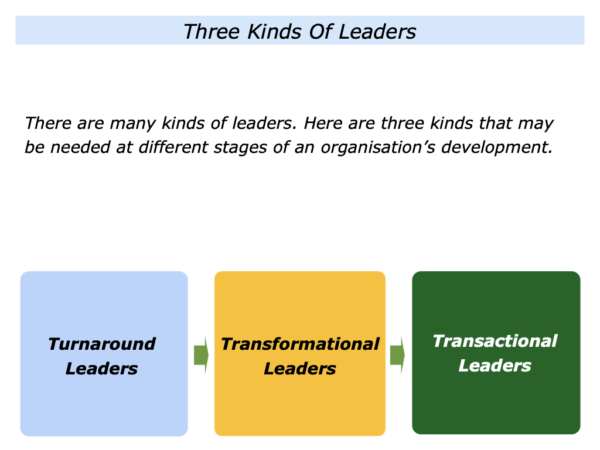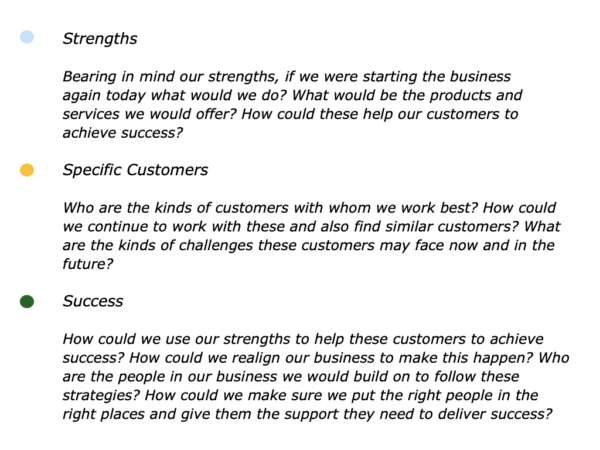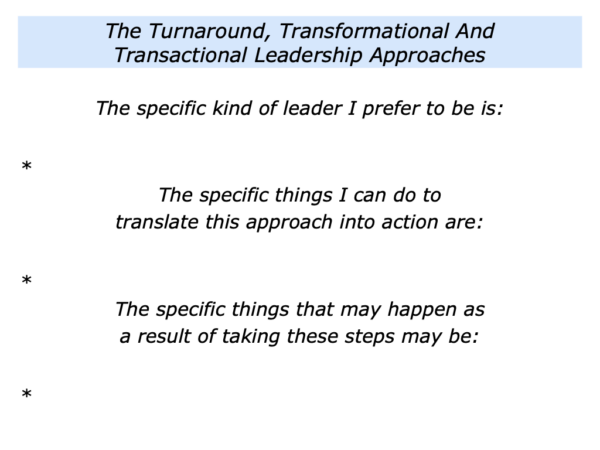
James MacGregor Burns coined some of these terms in the 1970s. He mainly studied political leaders, but the ideas have since been researched in organisations, business and other fields. This has resulted in expanding some of the original definitions.
Different organisations may need different types of leaders at different times in their development. So it is useful to know which type of leadership characteristics you demonstrate. Let’s explore the three kinds of leaders.
Turnaround Leaders
Such people love the challenge of turning around a failing system and making it work. They have a strong belief in their own ability to make this happen. They also have the resilience required to overcome obstacles and achieve the goal.
This can be a lonely job. So some take around with them a core team of people who help to make change happen. One such leader said:
“I love to go in and fix things. Maybe it is because of my background as an engineer. I analyse what’s wrong and get a picture of what is required. Then I implement the tough decisions required to make it work.
“Interestingly, once it is functioning well, I tend to lose interest. I can take something from 3/10 to 8/10 but am not motivated to take it to 10/10.
“I then get fascinated by the next turnaround project.”
This is not the case with all such leaders, but I have heard it from many. Some also take the further step of coaching their successors who will deliver ongoing success, but that involves developing a different skill.
Turnaround leaders sometimes take the following approach.
They clarify the organisation’s strengths and its potential future picture of success.
They clarify how to build on its strengths but also quickly fix the things that may be causing the haemorrhaging.
They work with a core group of people who follow the key strategies that will give the organisation the greatest chance of success.
They mobilise their people by continually focusing on the organisation’s purpose, principles and picture of success.
They may take action quickly to get some quick wins or improve the profits, products and people.
They keep pursuing the key strategies and get reality checks. This feedback is crucial. They focus on: a) The things that are working and do these more; b) The things that could be better and how.
They manage potential problems – maybe even turning some of these into opportunities – and find creative solutions to challenges.
They do whatever is required to turnaround the organisation and focus on the future picture of success.
They may hand over the reins and coach others to achieve sustainable success. Alternatively, they may simply move on. They then look for the next turnaround project.
Transformational Leaders
Burns believed that transformational leaders connect with people on a values level. They translate this into an inspiring vision and energise people to deliver visible results.
Some people love working for such leaders. They are encouraged to take ownership, combine their talents and continue to develop.
Transformational leaders are now seen to go much further than the original definition. Whilst connecting with people’s aspirations, such leaders often take some of the following steps:
They transform an existing system – such as radically changing an organisation.
They create a new system – such as building a successful prototype.
They introduce a new paradigm, a new way of thinking and change people’s consciousness.
Different transformational leaders focus on different themes when, for example, leading a business. Some take the following approach.
Today’s Business
They aim to build on the best of today’s business. They focus on certain customers and provide them with great service. This can maintain the cash flow and may also lead to getting more business with these customers.
Tomorrow’s Business
They often focus on shaping tomorrow’s business. Sometimes this involves imagining they were starting the business again today. One approach is for them to explore the following themes.


Transformational leaders may pioneer the way by changing the rules of the game. They may work as a sole contributor – such as an inventor, writer or philosopher – who shows people a new of way looking at the world. Alternatively, they may prefer to work with people on a tangible project.
Building on Burns’ original definition, they encourage a group of believers who translate the ideas into behaviour and deliver brilliant results. The new approach transforms the way people feel, think or behave in the future.
Transactional Leaders
Such leaders often operate within a given system and make things work more effectively. They get satisfaction from making incremental improvements on the road to achieving success.
Transactional leaders are vital if an organisation is to move from, for example, entrepreneurship to execution to excellence. One such leader said:
“My role is being an implementer. I like to have a clear goal and guidelines within which to operate.
“I then enjoy designing and delivering processes that enable people to succeed. Most of all, I enjoy doing real work and seeing a tangible result.”
Transactional leaders were somewhat tarred in the past because they were seen as process driven. But such leaders play a vital part in delivering the goods.
This is because not much gets delivered without good transactions taking place in a team, organisation or society. Warren Bennis, the respected author on leadership, wrote:
Leaders are people who do the right things; managers are people who do things right.
Good transactional leaders combine elements of both. They enable people inside a system to follow key principles and do the right things in the right way. Such leaders demonstrate some of the following characteristics.
They clarify the goal and the guidelines for implementing the strategy.
They get satisfaction from making things work successfully. So they may double check with the sponsors to ensure they are absolutely sure regarding what must be delivered and by when.
They have high professional standards and demand these from other people.
They are often hard working and diligent people, so they may fall into doing many of the tasks themselves.
It is vital for the stakeholders to ensure the transactional leader has the support to do the job. It is important to encourage the person:
To keep an overview of the tasks; to hire the right people, those with similar professional standards, and to delegate properly; to keep themselves healthy, because they can burn themselves out.
They translate the strategy into specific tasks that must be completed to achieve the goals.
They design processes that ensure the tasks are implemented properly. They do, if they are good leaders, give people a sense of ownership in implementing these processes.
They perform superb work, solve problems and ensure people deliver the required quality.
They continue improving the system’s effectiveness and efficiency. They keep their stakeholders informed and deliver the agreed goals.
Some people combine elements of being a turnaround, transformational and transactional leader. It can be important, however, for a person to decide which kind of situation they prefer. They are then more likely to guide people to success.
If you wish, try tackling the exercise on this theme. This invites you to describe kind of leader that you prefer to be and how you can translate this into action.







Leave a Reply